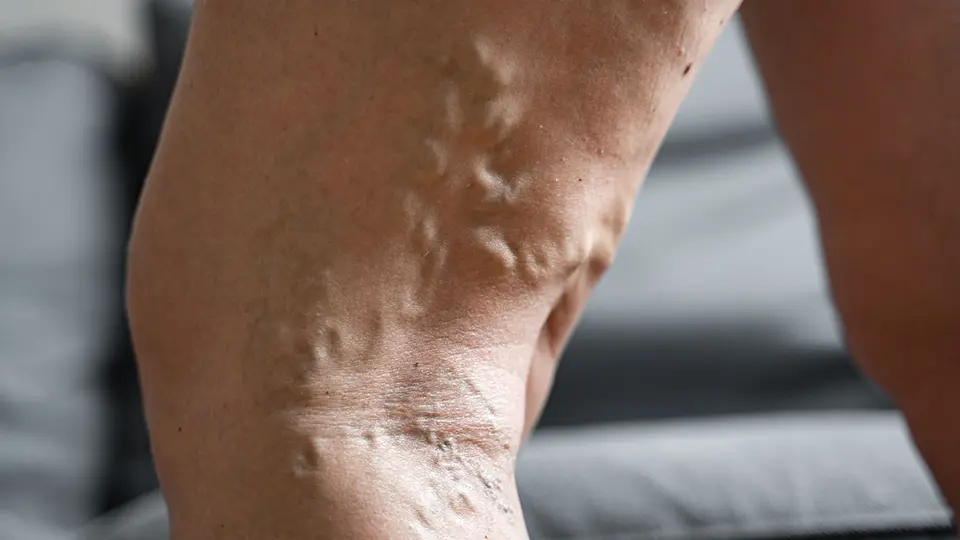Varicose Veins
What exactly are Varicose Veins?
Varicose veins are easily recognized in many people as bulging leg veins on standing or sitting. Unlike other lumps on the legs, when lying down, varicose veins will empty and disappear. This is because the veins are filling from underlying veins that have lost their valves, and blood falls down the veins by gravity. This blood falling the wrong way is called “venous reflux.” This venous reflux fills the surface veins, or “tributaries.” When this has been going on for a long time, the walls of the surface veins can stretch, causing the visible varicose veins.


The Visible Varicose veins
can be seen dilated tortuous, which is prominent in different sizes depending on the underlying reversal of venous blood flow. At the surface level, Varicosities are Medically known as Telengiectasis, Reticular veins, and Varicose veins.
By convention, tortuous veins >4 mm to 5 mm in diameter are referred to as varicose, veins between 1 mm and 4 mm in diameter are referred to as reticular, and veins <1 mm in diameter are referred to as telangiectasia.
Hidden varicose veins
About 15-20% of adults have varicose veins visible on the legs. However, what is harder for many people to understand is that another 9-20% of adults have “hidden varicose veins.”.
Symptoms associated with this condition include pain, cramping, itching, restlessness, and heaviness. In severe cases, ulceration of the skin occurs.
New techniques to treat varicose veins
Progress in Endovenous technology has recently focused much-needed attention on the treatment of varicose veins and venous ulcers. The spectrum of endovenous ablation techniques for saphenous veins includes the
- Injection of sclerosants
- Endothermal techniques – Radiofrequecy Ablation
- Non-thermal, non-tumescent ablation (glue therapy).
The current standards set by RF-radiofrequency ablation, namely an initial success rate of more than 99% in combination with very minimal side effects,.
These new technologies offer many potential advantages to patients. In our practice, all patients who are anatomically and clinically suitable for non-thermal nontumescent (glue) techniques are offered those options along with traditional endo-thermal ablation and radiofrequency ablation. The advantages and disadvantages of each approach, including the anticipated out-of-pocket costs, are discussed with every patient.
Vein and foot clinic, with experience of over two decades in Endo venous Treatment , we recognise and understand all contributing pathologies to venous hypertension and weighing all treatment options to prioritize care. Tailored Approaches to Each and Every Patient: Ensuring Appropriate Venous Care to our Patients with optimal delivery of venous interventions our focus. Our aim is to provide long-term, successful outcomes.
Don’t let vein issues affect your life.
Book a call with us
Conditions We Treat
- Varicose veins
- Superficial Venous Thrombosis / Phlebitis
- Thread / spider veins
- Swollen leg
- Deep vein thrombosis (DVT)
- May turners syndrome
- Varicose veins in pregnancy
- Varicose veins in obese patients
- Restless leg syndrome
- Varicose veins of the testicles
- Recurrent Varicose Veins
- Hidden Varicose Veins
- Hemosiderin Brown Stains
- Lipo dermatosclerosis (LDS)
- Venous Eczema
- Leg Ulcers
- Vaginal and Vulval Varicose Veins
- Pelvic Congestion Syndrome (PCS)
More about "Varicose Veins"
The 3 Stages of The treatments for abnormal veins of the legs and / or pelvis.
STAGE: 1
Medical
Identify and correct the underlying problem.
Successful treatment starts with finding out what is causing the disturbance of the blood flow, and understand all contributing pathologies to venous hypertension, weighing all treatment options to prioritize care, and then correcting the underlying problem in order to get the venous blood to flow correctly again. Depending on the exact nature of your veins and your own wishes, possible treatments include:
Radiofrequency Ablation (RFA)
- Glue (i.e., Venaseal™)
- Phlebectomies
- Post Operatively
- Bandage for 12 hours
- Stockings for 3 days.
STAGE: 2
Completing medical and prevention
Finishing the medical treatment and reducing future risks
Once the underlying problem has been fixed and the venous blood flow to the leg(s) has been restored, there are usually several abnormal veins that remain from the years of damage caused by the underlying vein problem.
Treatment in Stage 2 is usually ultrasound guided Foam Sclerotherapy.
Post Operatively Bandages and Stockings
- 14 days and nights (For good results)
- 21 days and nights (For optimal results.)
STAGE: 3
Cosmetic
The finishing touches
Once the venous blood flow has been restored to normal and all of the underlying vein problems have been treated, the green reticular veins and red, purple, and blue thread veins can then be treated with the highest chance of success using Microsclero therapy. This may require several sessions for required results.
Post Operatively Bandages and Stockings
- 14 days and nights (For good results)
- 21 days and nights (For optimal results.)
Treatments for Varicose Veins
Venaseal Glue Treatment
- Can be performed in the office/outpatient environment
- Is relatively painless?
- Very little bruising of the leg
- Minimal local anaesthetic required.
- Return to work within 24 hours.
Radiofrequency Vein Ablation
- Gold standard treatment of varicose veins (along with endovenous laser ablation)
- Keyhole treatment
- Relatively painless and return to work within 24 hours
- Useful in treating primary varicose veins
Closure Treatment
- Same day procedure
- Fast recovery – resuming normal activities within 1-2 days
- Minimal or no scarring
EndoVenous Laser Ablation
- Keyhole treatment
- All varicose vein sizes can be treated.
- Relatively painless with return to work within 24 hours
- Useful in treating primary and secondary varicose veins
Ultrasound – Guided Foam Sclerotherapy
- Keyhole treatment
- Useful in treating recurrent varicose veins
- Outpatient/office based treatment
- Compliments: laser and radio frequency treatment of varicose veins
- Relatively cheap
Vein Check-up
- At the Vein and Foot Clinic, we offer an early detection service for the potential risk of developing thread veins, varicose veins, pelvic varicose veins, and deep vein thrombosis (DVT).

